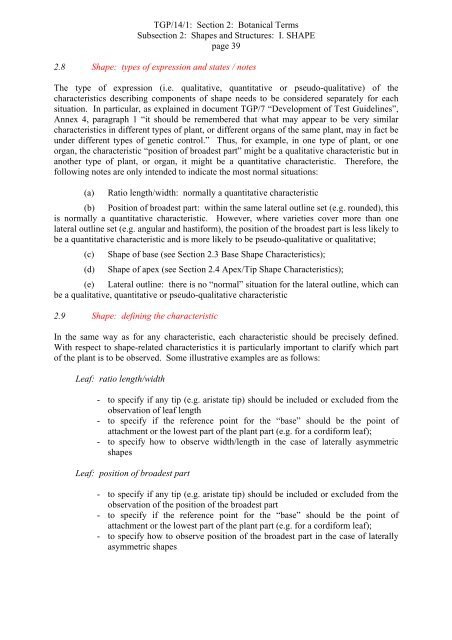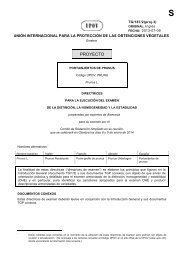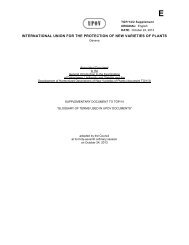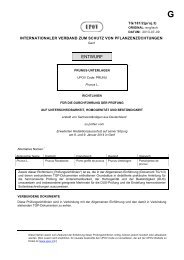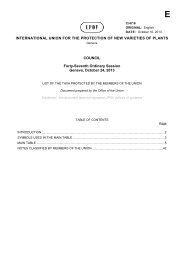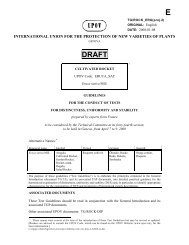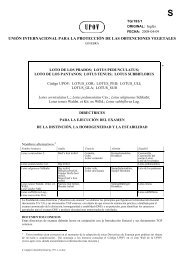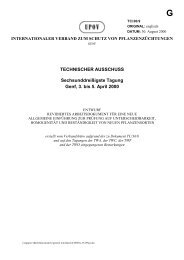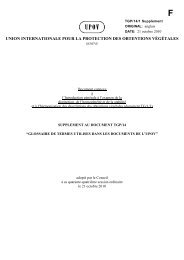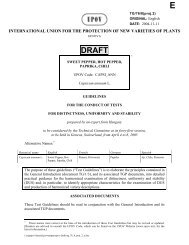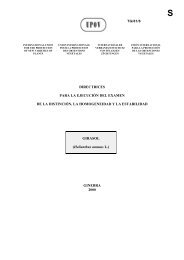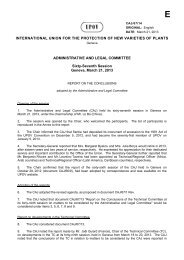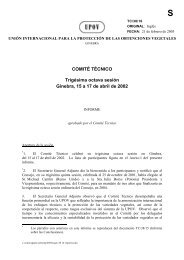E - International Union for the Protection of New Varieties of Plants
E - International Union for the Protection of New Varieties of Plants
E - International Union for the Protection of New Varieties of Plants
Create successful ePaper yourself
Turn your PDF publications into a flip-book with our unique Google optimized e-Paper software.
TGP/14/1: Section 2: Botanical Terms<br />
Subsection 2: Shapes and Structures: I. SHAPE<br />
page 39<br />
2.8 Shape: types <strong>of</strong> expression and states / notes<br />
The type <strong>of</strong> expression (i.e. qualitative, quantitative or pseudo-qualitative) <strong>of</strong> <strong>the</strong><br />
characteristics describing components <strong>of</strong> shape needs to be considered separately <strong>for</strong> each<br />
situation. In particular, as explained in document TGP/7 “Development <strong>of</strong> Test Guidelines”,<br />
Annex 4, paragraph 1 “it should be remembered that what may appear to be very similar<br />
characteristics in different types <strong>of</strong> plant, or different organs <strong>of</strong> <strong>the</strong> same plant, may in fact be<br />
under different types <strong>of</strong> genetic control.” Thus, <strong>for</strong> example, in one type <strong>of</strong> plant, or one<br />
organ, <strong>the</strong> characteristic “position <strong>of</strong> broadest part” might be a qualitative characteristic but in<br />
ano<strong>the</strong>r type <strong>of</strong> plant, or organ, it might be a quantitative characteristic. There<strong>for</strong>e, <strong>the</strong><br />
following notes are only intended to indicate <strong>the</strong> most normal situations:<br />
(a) Ratio length/width: normally a quantitative characteristic<br />
(b) Position <strong>of</strong> broadest part: within <strong>the</strong> same lateral outline set (e.g. rounded), this<br />
is normally a quantitative characteristic. However, where varieties cover more than one<br />
lateral outline set (e.g. angular and hasti<strong>for</strong>m), <strong>the</strong> position <strong>of</strong> <strong>the</strong> broadest part is less likely to<br />
be a quantitative characteristic and is more likely to be pseudo-qualitative or qualitative;<br />
(c) Shape <strong>of</strong> base (see Section 2.3 Base Shape Characteristics);<br />
(d) Shape <strong>of</strong> apex (see Section 2.4 Apex/Tip Shape Characteristics);<br />
(e) Lateral outline: <strong>the</strong>re is no “normal” situation <strong>for</strong> <strong>the</strong> lateral outline, which can<br />
be a qualitative, quantitative or pseudo-qualitative characteristic<br />
2.9 Shape: defining <strong>the</strong> characteristic<br />
In <strong>the</strong> same way as <strong>for</strong> any characteristic, each characteristic should be precisely defined.<br />
With respect to shape-related characteristics it is particularly important to clarify which part<br />
<strong>of</strong> <strong>the</strong> plant is to be observed. Some illustrative examples are as follows:<br />
Leaf: ratio length/width<br />
- to specify if any tip (e.g. aristate tip) should be included or excluded from <strong>the</strong><br />
observation <strong>of</strong> leaf length<br />
- to specify if <strong>the</strong> reference point <strong>for</strong> <strong>the</strong> “base” should be <strong>the</strong> point <strong>of</strong><br />
attachment or <strong>the</strong> lowest part <strong>of</strong> <strong>the</strong> plant part (e.g. <strong>for</strong> a cordi<strong>for</strong>m leaf);<br />
- to specify how to observe width/length in <strong>the</strong> case <strong>of</strong> laterally asymmetric<br />
shapes<br />
Leaf: position <strong>of</strong> broadest part<br />
- to specify if any tip (e.g. aristate tip) should be included or excluded from <strong>the</strong><br />
observation <strong>of</strong> <strong>the</strong> position <strong>of</strong> <strong>the</strong> broadest part<br />
- to specify if <strong>the</strong> reference point <strong>for</strong> <strong>the</strong> “base” should be <strong>the</strong> point <strong>of</strong><br />
attachment or <strong>the</strong> lowest part <strong>of</strong> <strong>the</strong> plant part (e.g. <strong>for</strong> a cordi<strong>for</strong>m leaf);<br />
- to specify how to observe position <strong>of</strong> <strong>the</strong> broadest part in <strong>the</strong> case <strong>of</strong> laterally<br />
asymmetric shapes


